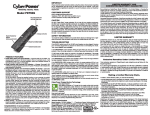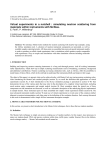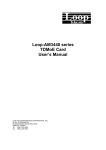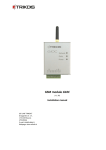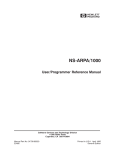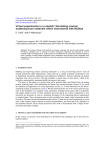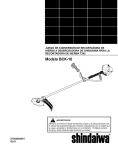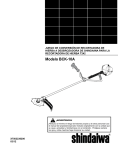Download FliDW HEWLETT a
Transcript
FliDW HEWLETT
a:~ PACKARD
Intraprocess Concurrency Under UNIX
Scott B. Marovich
Software and Systems Laboratory
HPL-91-02
March, 1991
concurrent/parallel
software,HP-UX,
IEEE 1003.4,
operating systems,
POSIX, threads, UNIX
Internal Accession Date Only
© Copyright Hewlett-Packard Company 1991
This paper describes a coroutine implementation of the Threads Extension for Portable
Operating Systems, defined in proposed IEEE
Standard No. 1003.4. Packaged as an HPUX subroutine library, it allows multiple
flows of control in a single program and
provides inexpensive, simulated concurrency
under a traditional, uniprocessor operatingsystem. We analyze problems of designing
such a mechanism for UNIX-style operatingsystems and give performance measurements
for two HP computers. The presentation is
for advanced programmers who wish to use
this software or build similar facilities, and
it assumes knowledge of UNIX system programming.
Contents
1 Introduction • • • • • •
• • • • • •.
•••
2 Design Problems and their Solutions • • • • • • • • • • • • • •
2.1 Execution Stacks • • • • • • • • • • • • • • • • • • • •
••••••••••
•••
2.2 Operating-System Errors
2.3 Asynchrony and Process Suspension. • • • • • • • • •
. •.
.••••••
2.4 Signals and Timing
2.5 Packaging Issues • • • • • •
.•••••.••••.
2.6 Application Debugging • • •
• • •
2.7 Problems of the IEEE Proposal • . • • • • • • • • . . • • •
••••.••••
•••
2.8 Open Problems • . • • .
3 Performance . . . . . . .
.
• • • • • . . • • • • • •
3.1 Measurement Conditions
. • . .
3.2 Process-Context Switching Time . • • • •
..••..••••
3.3 IEEE 1003.4 Metrics • • . . . • •
4 Discussion and Conclusions . • • • . . . . . . • . . • •
5 Acknowledgements • • . . • • • . • • • • .
..•..
6 References . . . . . . . . . . . . . . . .
.....
Appendix A: Operating-System Stub Replacements • • • • • . • .
• • •
Appendix B: Coroutine-Switching Marginal Costs. • • .
Appendix C: Process-Context Switching Time • • • • • • • • • • • •
1
2
3
4
5
8
10
13
15
17
19
20
21
21
31
32
33
37
39
43
List of Tables
Table 1.
Table 2.
Table 3.
Table 4.
Table 5.
Table 6.
Table 7.
Table 8.
Table 9.
Table 10.
Table 11.
Table 12.
Table 13.
Table 14.
Table 15.
Table 16.
Table 17.
Process-Context Switching Time (j-lS) • • • . .
Yield Time, Not Busy (j-lS) . • • • . . • • •
Yield Time, Busy . • • • • . . . • • . •
Scheduler Overhead (j-lS)
• • . • • • • • .
Mutex Lock/Unlock Time, No Contention (j-lS)
Mutex Lock/Unlock Time, Long-Term Contention.
Lock Manipulation Time (j-lS) • • . . • • •
Condition Signal Time (j-lS)
•••••.•
Condition Broadcast Time (j-lS) • • . • • . .
Condition Signal Time, Outside Critical Section. .
Condition Signal Time, Inside Critical Section • •
Event Manipulation Time (j-lS)
...•..
Event + Lock Manipulation Time (j-lS) • • • . .
Condition Signal Time, Outside Critical Section. .
Condition Signal Time, Inside Critical Section
Event + Lock Manipulation Time (j-lS) . . . . .
Process-Context Switching Time (j-lS) • . . . .
- 1-
• . . • • .
• • • • . •
. • • . • •
• • • • • .
.•••••
• • • •
. • •
• • •
. • . • • .
• . . . . •
• . . • • •
. • .
. • • • • •
• • • • • •
. . • •
. . • . • .
. • . • • .
21
25
25
26
27
27
27
28
29
29
29
29
30
30
30
31
44
1 Introduction
As computer users seek faster performance by distributing parts of an application
among several central processing units (CPUs), exploiting opportunities for concurrency has become an important principle for organizing software. As a result,
there is also an interest in low-cost simulations of concurrency using a single CPU
under a traditional operating-system. It is often thought that conventional multiprogramming is too costly for this purpose, due to the time required for process-context
switching [1], so there has been much recent discussion of what are called light
weight processes: multiple, independent flows of activity within a task that share
some of its hardware-state information, such as the content of memory. By reducing
the amount of information that distinguishes each flow, which must be saved in
memory and restored to the CPU whenever one is interrupted by another, it is
thought that shared hardware can be multiplexed among such flows much faster than
among traditional operating-system processes. How best to do this is a topic of much
current research.
The MACH operating-system treats a flow of activity (which its literature calls a
thread of control, or just a thread) as a fundamental abstraction that is representedby
internal data structures and manipulated by new operating-system services [26], We
use MACH terminology and refer to some of its ideas, but we describe an alternate
implementation using coroutines, managed by a subroutine library. Within an application program, our mechanism provides an inexpensive simulation of concurrency on
a uniprocessor computer, using an unmodified, traditional operating-system. Our
library was built and measured on HP 9000 Series 300 and 800 computers, under
Version 7.0 of HP_UX™, Hewlett-Packard Company's version of the UNIX™
operating-system, using techniques that apply broadly to other versions of UNIX. It
presents the same application program interface (API) that is proposed for IEEE
Standard No. 1003.4 [15]1.
Using coroutines to simulate concurrency is not a new idea [10]2, but using an
industry-standard API is. Not all details of the IEEE proposal are final, but because
many vendors seem likely to support it, understanding its provisions is important.
The work described here is a trial implementation to assess construction problems, to
™ HP-UX is a trade mark of Hewlett-Packard Company.
UNIX is a trade mark of UNIX System Laboratories, Inc.
1. The most recent version of the proposed thread facility at the time of writing is a supplementary chapter (or an appendix?),
distributed as a separate, unapproved draft, numbered PlO03.4a and entitled: Threads Extensions for Portable Operating
Systems, Draft 4 (10 August 1990). Assuming eventual incorporation into the full document, and despite possible ambiguity
at present, we use number 1003.4 to identify its thread facility without expecting confusion, since we discuss no other part of
the standard.
2. The subject has an extensive history and literature, covering parallel computation and discrete-time simulation for many programming languages and operating-systems. Recent examples for the C language under UNIX include [3,4,6,7,8,16 (or 25,
Ch.6)].
1
compare the performance of our system with that of ordinary multiprogramming, and
to provide Hewlett-Packard software developers with a way to experiment with the
proposed facilities.
Section 2 analyzes some problems of designing a general-purpose, library-based
coroutine mechanism for UNIX and how this implementation solves them. Many of
these techniques have undoubtedly been discovered before, but they seem to be inadequately documented in earlier literature. Section 3 gives performance measurements,
including metrics required by the IEEE proposal, and it compares the speed of
thread-context switching to that of ordinary process-context switching. Section 4
discusses the implications of our results.
2 Design Problems and their Solutions
Our coroutine system was built for HP 9000 Series 370 and 835 computers, two
engineering workstations with different architectures but comparable performance''.
Optional features of the IEEE proposal that it supports include: a thread stack size
attribute, real-time scheduling, and per process signals. However, reentrant versions
of C Library subroutines are not yet supported (cf. §2.8.1). Our code is packaged as
an augmented copy of the C Library, and it is initialized by a modified version of the
library's start-up module, crtO. The package also replaces about forty system-call
interface subroutines, both in the C Library and one for NetlPC™, an optional X.25
software product.
The system runs under HP-UX Version 7.0, a combination of A.T.&T. UNIX System
V, Release 3, with features of 4.2BSD and 4.3BSD UNIX, a fact which substantially
increases both the number of operating-system services that the coroutine package
must emulate (cf. §2.3) and the implementation effort. The IEEE proposal defines
new POSIX operating-system services altered semantics when an application has
more than one thread, that HP-UX does not support but to which it provides
equivalent functionality for single-thread programs in a different way. In these cases,
we try to extend HP-UX functionality in the spirit of PQSIX.
Our package contains about one-hundred modules. Stubs and other machinedependent subroutines are coded in assembly language, while the rest are coded in C.
The total implementation effort for two computer systems described here was about
three engineer-months.
The next sections present additional details while they describe the project's chief
design problems and their solutions.
3. Series 835 is about twice as fast as Series 370 in CPU-intensive, standard bench marks but it is only a little faster in
memory-intensive programs.
™ N etIPC is a trade mark of Hewlett-Packard Company.
2
2.1 Execution Stacks
Each thread of control, or coroutine, in a process requires its own "push-down stack"
for private arguments, local variables, and machine-state information that must be
saved when its execution is interrupted, so an implementation must include a
memory allocation mechanism for these stacks. The mechanism should be transparent enough that a programmer need not worry about stack overflow nor be called
upon to predict a stack's maximum size, but it is difficult to satisfy this requirement
under UNIX.
Ordinarily, a UNIX process has a single execution stack at a fixed virtual-memory
address that holds contiguous procedure-activation records (stack frames). The
operating-system automatically detects stack overflow and extends this memory
region accordingly. The fact that UNIX can treat only a single region in this way
becomes a problem if a process has more than one thread of control, and there are
two obvious solutions.
The most convenient and reliable alternative uses the automatic mechanism by timesharing the memory region: A coroutine implementation copies the content of a
thread's stack to the shared region before it resumes a thread's execution, and it
copies the region's content back to a unique "save area" when it suspends the thread's
execution. This method is robust and makes stack management transparent to an
application program, but thread-context switching can be slow; in fact, the time is
unbounded, because the amount of memory copied-twice!-is proportional to the
stack's size at that moment.
A faster, but risky alternative is to ignore the operating-system's automatic mechanism by allocating several distinct memory regions for thread stacks, and to choose
among them by reloading a "stack pointer" CPU register during each thread-context
switch. This is faster than copying a stack's content, but overflow cannot easily be
detected, so each region must be large enough to prevent it. Moreover, a stack cannot
easily be relocated were enlargement required, because it may contain addresses of
other variables in the region, which would require detection and adjustment, so it is a
practical necessity to specify fixed region sizes in advance. The IEEE proposal
includes a mechanism for programmers to optionally do so, but they usually do not
have enough information for accurate estimates, so an implementation must pick a
reasonable default size. If an enormous size is chosen in order to minimize the risk of
disaster, a program that creates a large number of threads can exhaust the amount of
secondary storage available for virtual-memory paging, since UNIX employs the
''banker's algorithm" [12] to preallocate space for each process' main-memory data.
MACH solves this problem using a lazy evaluation strategy [27]: Assigning main
memory and secondary storage to virtual-memory pages is deferred until a process
tries to use them, whereupon it is done in small increments, upon demand", When
3
only a. little stack space is used, many large memory-address ranges can be reserved
at low cost. Unfortunately, this solution is unavailable under most versions of UNIX.
A different problem arises if threads are used to implement programming language
features like ADA tasks [2]5, which may share variables that are declared in a common, non-global lexical scope, and which a compiler usually allocates on a thread's
execution stack. In most block-structured languages, these variables are accessed
using a display or a chain of static-environment pointers [20], which refers to memory
locations in a thread's stack but is not usually modified during thread-context switching. If stack frames are allocated contiguously (as in most versions of UNIX, for fast
subroutine calls), storage for these variables is duplicated in each sharing thread's
stack. This is harmless-if wasteful-when stacks occupy distinct, non-copied
memory regions, since a display or static-environment pointer can refer to only one of
the copies. But if a single memory region is multiplexed among stacks and a thread
updates a shared variable, the next thread-context switch will copy the new value to
that thread's "save area" without propagating it to those of other sharing threads. If
any of the latter then reads the variable, an obsolete copy of the value will be
retrieved, violating the semantics of "shared" memory! Noncontiguous stack-frame
allocation is an alternate solution to this problem, but few versions of UNIX provide
it.
Hence, the choice of stack allocation strategy under UNIX is a trade-off between
between convenience with robustness, and speed. The author built two versions of
the coroutine package described here in order to compare execution times using
(non)copied stacks; the results are described in §3.
2.2 Operating-System Errors
When an application program requests an operating-system service and an error
occurs, UNIX returns a code number in a global variable named errno. If a process
contains several threads that request services concurrently, errno effectively
becomes a shared variable; however, the implementation must still arrange that error
codes are somehow routed to the proper threads. The IEEE proposal suggests several
solutions:
• Change all operating-system services to return the code number using either a signal or an extra argument, passed ''by reference" to each service. Except perhaps in
new UNIX implementations, downward-compatibility requirements make this
unreasonable.
4. This can lead to deadlocks if a process tries to use more memory than is available at that moment, but MACH's builders
assume that this circumstance is rare, so they deliberately sacrifice robustness for speed.
5. The IEEE proposal does not require such support, but it strongly encourages it.
4
• Reimplement errno as an explicit, per thread variable. The proposal recognizes
that this requires special support from a compiler, linker, and/or virtual-memory
system.
• If application programs are coded in C, use the compiler's cpp(1)6 macro preprocessor to redefine errno as a function which reads an implicit, per thread variable.
This is a language-specific kludge, but it is probably the most practical solution for
a multiprocessor computer.
In a uniprocessor simulation of concurrency, there is a much simpler solution: during
a thread-context switch, just save the value of a global errno variable on the
suspended thread's stack and restore an earlier value from the resumed thread's
stack. This is like the LISP implementation technique called shallow binding [5], and
it is the method we use.
Another, less serious problem is that the IEEE proposal introduces a new POSIX
error code that is not supported by HP-UX. Named ENOTSUP, it denotes an
attempt to use a defined, optional facility that is unimplemented, unconfigured, temporarily disabled, or otherwise unavailable. To avoid changing too many standard
HP-UX files, we temporarily use the header file < pthread.h > to assign code number
47, the next code after those defined in < errno.h >, the definition's proper location.
Any future product based on our work will have a permanent definition in the latter
file.
2.3 Asynchrony and Process Suspension
A uniprocessor simulation of concurrency exhibits no speed-up unless it can overlap
computation with an activity, such as I/O, that would ordinarily cause a process to be
suspended. Because a process can only be suspended by the operating-system in
response to a service request, the simulation must change the way in which such a
request is made.
The most common cause of suspension is an I/O request, since UNIX I/O is synchronous by default. For instance, a programmer who requests a read(2) service ordinarily expects the operation to be finished when control of the CPU returns from the
corresponding subroutine call, so if no input is immediately available, the operatingsystem suspends the program-and may resume another-while waiting for it. UNIX
programs can overlap computation by requesting asynchronous I/O, in which the
operating-system starts a data transfer but returns control immediately-ihen is
6. This form of citation identifies a topic in a numbered section of the on-line UNIX Reference Manual in the same way as other
literature about this operating-system. Most dialects of UNIX are sufficiently alike that any version of the manual may be
consulted. Similar generic citations are used throughout this paper.
5
queried for completion later-but the UNIX mechanism for this is clumsy, so programmers rarely use it.
Other operating-system services also cause a process to be suspended. For instance,
wait(2) blocks until a subprocess finishes execution, and pause (2) blocks until a signal is received (from a process invoking kill(2». HP-UX also includes UNIX System
V inter-process communication (IPC) facilities involving semaphores and message
queues, whereby one process can be suspended pending certain actions by another.
Altogether, some thirty HP-UX service requests can trigger suspension.
But if a process has several threads of control and one of them requests one of these
services, we do not wish to suspend the entire process, but only the invoking thread.
If the operating-system immediately returns control of the CPU, the process can
resume another thread while the service is performed. Thus, from a process' point of
view, I/O and similar services should be performed asynchronously and concurrently,
but the default behavior presented to each thread should be synchronous', A coroutine simulation must therefore mediate and transform a thread's operating-system
requests in order to suspend and resume threads, plus do whatever ''bookkeeping'' is
necessary to preserve this illusion, while avoiding process suspension when it has
threads that can execute.
2.3.1 Stub Replacement
Since a coroutine package consists of library subroutines in an application program's
virtual-memory address space, which must communicate with the operating-system
in the same way as other application code, how can the package alter operatingsystem requests? Our method of intercepting and transforming these relies on a
trick.
Most computers use special machine instructions to enter an operating-system, which
can only be coded in assembly language. In order to let calls be written in a higherlevel language, the UNIX C Library provides a mediating "stub" subroutine for each
service, containing the necessary instruction(s). By replacing these stubs, one can
intercept and transform all operating-system request except perhaps those written in
assembly language, but these are rare under UNIX. Appendix A lists the stubs
replaced by our implementation. There are two replacement techniques that make it
fairly transparent to an application programmer.
One method uses systematic renaming: For each stub subroutine S, the coroutine
package includes a replacement stub S' with the same parameters, which either
transforms a caller's arguments before invoking S or performs an alternate action.
7. If a thread explicitly requests asynchronous service, the request should be honored by passing it directly to the operatingsystem.
6
Application program references to S, references are then systematically changed to
S ', This is less difficult than it sounds, since programs written in C, the most popular language under UNIX, can be automatically transformed using the compiler's
cpp(l) macro preprocessor. The Concert Multithread Architecture (CMA) [8] uses
this technique. Its limitations are inherent in the mechanism: Macro calls must conform to the syntactic idiosyncracies of a particular language and compiler technology,
text substitutions may occur in unexpectedplaces-causing obscure errors, and mediating subroutines may unexpectedly usurp names that a programmer intends for
other purposes. A second problem is inefficiency, since the technique introduces extra
subroutine calls between an application program and the library stubs. A third problem is that it demands recompiling all program modules that refer to the candidate
stub, which may preclude other subroutine libraries or proprietary code for which no
source text is available. On the other hand, this technique is reasonably portable
when programs are coded in C, and it sometimes allows another library to be reused
without modification.
The second method is to change (a copy of) the C Library. A coroutine package could
theoretically be isolated in a separate library that supplements and overrides the C
Library, but the UNIX linker makes this inconvenient (cf. §2.5.), so merging them is a
practical necessity. One difficulty is that stubs written in assembly language are not
portable; hence, the same can be said of modifications. The coding of UNIX systemcall stubs is sufficiently arcane that there is also a risk of incompatibility if the original and replacement stubs are written by different vendors and the originals, usually
undocumented, are poorly understood. However, this technique makes a coroutine
package easier to use with a variety of programming languages, it preserves application program efficiency, and because application programs do not need recompilation
(they do need relinking), not all modules need be available in source-program form;
therefore, our package uses this method.
2.3.2 Simulation Mechanism
The basic mechanism used by our system to schedule asynchronous I/O is the
select(2) operating-system service, which returns sets of UNIX File Descriptors that
are ready for service by an application program and which can optionally suspend the
process for a time, pending I/O completion or signal delivery. The package implicitly
opens all of a program's files for asynchronous I/O, but it uses a bit vector to note
File Descriptors for which synchronous I/O must be simulated. Since fcntl(2)
requests can alter this data, they too must be intercepted and modified. An internal,
"scheduler" subroutine repeatedly polls the operating-system using select(2), and it
™ Concert Multithread is a trade mark of Digital Equipment Corporation.
7
either dispatches an executable thread after suspending another, or else it asks that
the entire process be suspended until some thread(s) can proceed.
Some synchronous operating-system services are simulated in other ways. The
scheduler is periodically interrupted by UNIX Alarm Clock (SIGALRM) signals" for
preemptive round robin scheduling (time slicing), and the package's internal
"handler" subroutine then does some extra work:
UNIX System V IPC facilities cannot indicate a need for attention using select(2), so a
process must query them in other ways. Stubs for these services have a loop that conditionally suspends a client thread on a global "timing queue" so that the operatingsystem is asynchronously polled after each Alarm Clock signal, until it indicates that
the client's request was serviced.
A synchronous select(2) request is simulated in the same way. The implementation
maintains a global "I/O queue", plus bit vectors of File Descriptors for each thread
suspended on it. When the package's scheduler calls select(2), it asks the operatingsystem about the union of all of these File Descriptors and it resumes any thread(s)
awaiting information about those ready for service. A thread may be removed from
the queue and resumed sooner if the Alarm Clock signal handler detects expiration of
a time-out interval, optionally specified by a thread when it calls select(2) (ct. §2.4 for
more about timing).
The pause (2) and wait(2) operating-system services ordinarily return when a process
receives certain signals. Like select(2), they are simulated using a global "signal
queue", plus a bit vector per thread, except that when a thread is suspended in this
queue, its vector indicates the signal(s) it awaits.
Signals also create other problems, which we consider next.
2.4 Signals and Timing
In addition to scheduling threads and simulating operating-system services, a coroutine package must intercept UNIX signals for a further reason.
The IEEE proposal divides signals into two classes. Synchronous signals indicate
conditions attributable to a particular thread, such as division by zero, floating-point
arithmetic errors, attempted execution of an invalid machine instruction, memory
reference errors, or an error in an operating-system service request. The proposal
requires that these signals be delivered to the thread that causes them. All other signals, termed asynchronous, indicate conditions that cannot be attributed to a particular thread'', and the proposal lets them be delivered to any thread-most
8.
cr. alarm (2) and signal (5).
9. In our implementation, for example, an Alarm Clock signal is considered asynchronous.
8
conveniently, to whichever one is executing when a process takes delivery. But, what
if all threads are suspended then? If an aPRlication program's signal handler expects
to use the C Library longjmpO procedure 0 to resume execution at a predetermined
recovery point, and if an underlying coroutine package uses the stack-copying method
of thread-context switching (§2.1), the package risks disaster unless it either ignores
the signal or else forcibly installs the stack of the thread whose setjmp (3C) call established the recovery point. Of course, ignoring a signal can induce application program errors, but identifying an arbitrary thread that previously called setjmp (3C)
may be impossible, so our package implements a compromise: it installs the stack
belonging to a process' initial thread'! in order to handle an asynchronous signal.
To meet all of the needs described here and in the previous section, our coroutine
package arranges with the operating-system to receive signals internally, where it
filters them, performs simulation steps, then calls any handler(s) an application program may have requested. The latter requires mediating any program requests that
(un)install handlers or change a process' signal mash'". Our package preserves a process' initial handlers and mask, asks the operating-system to deliver all signals to it,
then simulates whatever modification of the initial state a program requests. Since
HP-UX supports several interfaces to its signal management facilities, seven C
Library stubs must be replaced for this purpose alone.
An application program may request delivery of Alarm Clock signals, which the
coroutine package also needs, so our system must simulate certain timing facilities by
mediating operating-system requests that manage them, including alarm (2), getitimer(2), and setitimer(2). The setitimer(2) service normally allows a program to
enable or disable clock signals at times specified, with microsecond resolution if the
underlying hardware allows it. Of course, our package's scheduler cannot perform a
thread-context switch so quickly and, in fact, the scheduler's overhead is likely to be
intolerable unless its time-slice interval for thread preemption is considerably longer
than the thread-context switching time. The package therefore requests Alarm Clock
signal delivery at an interval equal to the greatest common divisor of a time slice and
any interruption interval an application program may have requested by calling
setitimer(ITIMER_REAL, ... )
We then use software counters to simulate an interruption of the scheduler every s
signals and an interruption of the application program every u signals, where s and u
are ratios of the respective intervals to the g.c.d. Currently, we implement a degenerate case in which sis 1, effectively quantizing application requests in multiples of a
10. Cf. setjmp (3C).
11. In C, this is usually the thread that executes an application's mainf) program.
12. Cf. sigvector(2).
9
time slice, which is 200 mS. If an application program's operating-system requests
indicate that it wishes to ignore Alarm Clock signals, our package's internal handler
continues to receive them but merely stops relaying them to the application.
The package must forestall delivery of Alarm Clock signals to avoid interruption
while it manipulates scheduling queues and other internal data structures. One way
to do this is by invoking sigblock(2) or a similar operating-system service around such
critical sectione'" but since these are short and numerous, the execution-time cost is
high. Our package uses a faster solution: A lock variable in the application
program's virtual-memory address space is set and cleared around critical sections,
and it is tested by the package's signal handler. When the lock is set, Alarm Clock
signals are considered to be logically "masked", so the package's handler dismisses
them without action. Most modern computers, including the two described here,
have machine instructions to manipulate such locks atomically, at high speed. An
alternate technique, used in the /lSystem [7], is to locate all of a coroutine package's
code in a single, contiguous, virtual-memory address range, so that a signal handler
can perform a quick range check to decide whether an interrupted instruction belongs
to the package or to application code. But segregating modules in this way either
requires compiler and linker support that is not available under all versions of UNIX,
or else it requires that a coroutine package be pre-linked into a single module, which
negates the "pay only for what you use" code size benefit of making it a library.
It can argued more generally that delivery of all asynchronous signals should be
masked during an internal critical section, since an application program's signal
handler might call some other subroutine defined in the IEEE proposal (e.g.,
pthread yieldO) that manipulates data structures perhaps left in an inconsistent
state by
interruption. Although Alarm Clock signals always recur, other signals
may not, so a thread implementation cannot afford to ignore them. But since delivery
cannot be postponed without costly operating-system intervention, our package relays
other asynchronous signals to an application program even during an internal critical
section, thereby admitting a possible source of error in the interest of speed.
an
A final problem created by internal critical sections is that ignoring Alarm Clock signals induces delay in the package's simulation of UNIX timing facilities.
2.5 Packaging Issues
Any mechanism that simulates operating-system facilities should be transparent to
an application programmer; it should be as general and easy to use as the mechanism
it replaces, and it should support as many programming languages'" with as few
13. Dijkstra's terminology [12].
14. The IEEE proposal currently defines only a C language binding, but we anticipate that other bindings will be specified in
time.
10
surprises as possible. This objective dictates not only coding choices, but also packaging decisions that are compatible with common UNIX programming tools and procedures. Since our coroutine implementation is a collection of subroutines, the most
obvious package is an archive library file 15 that supplements and overrides the standard C Library. However, this is inconvenient for two reasons; one of them involves a
design weakness of the UNIX linker, ld(l), and the other concerns package initialization.
To understand them, one must appreciate that most UNIX C programs are built
using the convenient cc(l) command, which automatically compiles and links a
program's modules, arranges to link C Library subroutines, prefixes a special crt016 ,
library module that initializes and calls a mainO program, optionally appends a
debugger-support module, and substitutes library modules as necessary when support
for execution profiling is requested. A "cc" command may specify a list of supplementary and overriding libraries to which the C Library is automatically appended, and
the linker searches these libraries for unresolved module references in the order
listed.
2.5.1 Linker Limitation
A restriction imposed by almost all versions of the UNIX linker is that a list of
libraries is searched only once, in the forward direction. An unresolved reference in a
library module must therefore be satisified either by:
• a module that is already linked, or
• another module in the same library, or
• a module in a library that appears later in the list.
Backward searches for additional library modules are not allowed. This creates a
problem when one wishes to override operating-system stubs in the C Library, always
last in a list, since other C Library modules refer to these stubs as well. Such internal
references cannot be. linked to replacements in a preceding library. In order to
replace a stub, a programmer must either guarantee that a reference to it occurs earlier in the library list or else identify the replacement module, extract it from its
library, and explicitly request that it be linked. Either alternative is clumsy and
error-prone.
As an example, consider a frequently used C Library subroutine in the Standard I/O
package such as getchar0 17 , which calls a hierarchy of subroutines in the same
15. Cf. ar(l) and ar(4).
16. The module is named for and initializes "C run-time (location) 0", the virtual-memory address at which the exec (2) operatingsystem service starts a new program.
17. C{.getc(3S).
11
library, ultimately invoking the read(2) operating-system service. It should not be
necessary for programmers to know of this dependency, but since our coroutine package must replaca the read(2) stub (in order to overlap input with other activity;
cf. §2.3), getcharO won't work if our system were packaged in a separate library,
unless a programmer knows enough about both packages' internal organization to
explicitly link the replacement stub. Similar scenarios could be constructed for many
other library subroutines, all equally annoying,
In order to solve the problem, either the linker's library-search algorithm must be
changed or else the coroutine package must be merged with standard subroutines in
one library. The first option offers the greatest generality and convenience, but it
requires redesigning the UNIX linker. Most other operating-systems' linkers offer
the functionality we need by doing library searches iteratively, but this entails more
execution time and/or memory than a "one pass" algorithm. The UNIX linker's
designer thought that such a feature would rarely be necessary, so it was omitted in
order to improve performance in simple cases. Unfortunately, adding the capability
takes more time than we could spare, so we did not pursue the matter.
Directly merging our coroutine package into the standard C Library seemed inconsiderate because it imposes a small, but gratuitous performance penalty on ordinary,
single-thread applications, as well as some implementation restrictions, so we copied
the library under a different name and merged our package into the copy. To compile
and link a multiple-thread application, a user of the cc(l) command must specify the
copy as the last (or only) library in a list, and the standard C Library will then be
ignored by the linker. A user who invokes ld(l) directly must specify one library or
the other but need not request both.
2.5.2 Package Initialization
Our coroutine package requires run-time initialization that, for the sake of transparency and convenience, should be hidden from an application programmer and
should occur before an application's mainf) program is entered. These functions
include:
• Allocate and initialize memory for internal data structures.
• Create (data structures representing) a process' initial thread of control.
• Reopen a process' standard input, output, and error streams for implicitly asynchronous I/O.
• Ask the operating-system to install the package's signal-handling subroutines and
to deliver all signals.
• Start Alarm Clock signals.
This code also invokes the sigstack(2) operating-system service to request that signal
handlers be called using a special, internal stack, so that they can safely alter the
stack of an interrupted thread.
12
Initialization code could potentially be invoked in one of several ways; for instance,
the package could require that a programmer call an initialization procedure explicitly, or it could arrange that each call of a user-visible subroutine implicitly tests
(and conditionally sets) an internal variable, indicating that initialization has been
accomplished. The first option is inconvenient, and its accidental omission can cause
errors, while the second is inefficient. Our implementation therefore calls an initialization procedure from the C Library start-up module, crtO. To avoid linking our
package with ordinary, single-thread applications, while also avoiding two versions of
this module, we use a linker-dependent trick".
The start-up module calls the initialization procedure indirectly through a "pointer"
variable, but only if the variable's value is not zero. The variable is defined in the
start-up module, but it is not initialized there; instead, the variable is redeclared in
the module containing the initialization procedure, where it is bound to the
procedure's entry-point address. (It is guaranteed that the initialization procedure
cannot begin at address 0, since that is where the start-up module begins.) Moreover,
the latter module defines all of the package's statically-allocated variables, so crossmodule references insure that the linker will incorporate it in any application program that includes other modules of the package. If a program does not use the package, then there are no references to its data, so the initialization module is omitted
and the linker silently makes the pointer's value zero, thereby insuring that no call is
attempted. But if the initialization module must be linked in order to satisfy external
references, the linker merges its (non-zero) pointer value into the resulting binary
file, making it accessible to the C Library start-up module, which insures that the initialization procedure will be called. In other words, the pointer is treated much like a
conditionally initialized FORTRAN COMMON variable.
2.6 Application Debugging
Debugging a multifie-thread application program under a conventional operatingsystem is difficult' , because most debuggers assume that a program contains only
one flow of control and are not designed to distinguish among several. In fact, designing a debugger for multiple threads is hard because:
• All debuggers require implementation-specific knowledge of how a program and
its data structures are represented, and they usually require operating-system
assistance to set and clear ''break points", detect unexpected memory "store"
instructions, "single step" through individual machine instructions, etc.
18. The idiosyncracy making it possible is apparently undocumented, perhaps because it is so much a part of system programming "folklore" that no formal description is thought necessary. The author discovered it by reading Carnegie-Mellon
University's MACH code, but this is probably not the original source. A documented attribution is welcomed.
19. General problems of debugging multiple-thread applications have been discussed in other contexts; e.g., [9].
13
• The queries that a multiple-thread debugger should be able to answer and the
most appropriate interface through which to ask questions and receive answers
are topics of current research.
There are few standards in this area yet, so most application programmers must use
an ordinary, single-thread debugger and resort to detailed knowledge of a thread
mechanism's internal implementation. This section describes several peculiarities of
our package that make debugging difficult.
Each thread in our implementation is represented by a unique, internal data structure, and there is a statically-allocated, global variable that contains the address of
one of these structures, identifying the thread in execution at that moment. (If there
is no such thread, the variable's value is zero.) When an application program stops at
a debugger ''break point", a programmer may examine the variable to identify a
stopped thread, and a debugger that supports "conditional break points" can test the
variable to determine whether a particular thread should stop there. This technique
is crude, and it would be more elegent to absorb such functionality into the debugger
itself, but we did not have enough time.
The fact that our package is periodically interrupted by Alarm Clock signals (§2.3.2),
together with a property of Motorola MC68000-series CPUs, badly disrupts the operation of debugger ''break points" and "single step" commands on Series 300 computers.
The "single step" problem arises because:
• This feature is usually implemented using the CPU's trace facility [19, Ch. 8],
which involves setting a bit in the machine's Status Register so that a hardware
exception is raised before the next User Mode instruction is executed.
• Alarm Clock signals occur every 200 mS, so when a programmer tries to "single
step" a stopped program, a signal delivery to the process is nearly always pending.
As a result, the next User Mode instruction to be executed is the one that begins the
coroutine package's signal handler, not the one before which the program stopped.
Unless a programmer is prepared to "single step" through the entire signal handler,
which takes so long that many further Alarm Clock signals occur in the meantime(!),
it is impossible to make forward progress through the rest of an application. What is
needed is a way to disable the trace facility between memory addresses occupied by
signal-handler instructions, but the ptrace(2) operating-system service, through
which it is manipulated, has no such option.
Debugger ''break points" evoke a similar problem. These are implemented by temporarily replacing the machine instruction at the desired stopping point with a TRAP
instruction, which raises a hardware exception. In response to this, the operatingsystem stops the program until the debugger issues a ptrace(2) command to restart it,
and it delivers a Trap signal (SIGTRAP) to the debugger, informing it of the halt. If
a programmer then types a debugger command to continue, the original instruction is
restored and execution is resumed. But if delivery of an Alarm Clock signal to the
14
program is pending by the time a command is entered (as it usually is, since these signals arrive faster than most programmers can type!), a "race" condition can occur
between signal deliveries to the two processes, and by the time the debugger learns of
the TRAP instruction, the application program has halted at the beginning of the
package's Alarm Clock signal handler. Since the debugger "remembers" where it
installed the TRAP instruction, it becomes quite confused when the program appears
not to have stopped there. Fortunately, there is a simple solution: When the coroutine package first registers its signal handlers with the operating-system, using the
siguector(2) service, it asks that delivery of Trap signals be masked while Alarm Clock
signals are handled. Since a debugger can correctly determine a TRAP instruction's
address after an Alarm Clock signal handler returns control of the CPU to the point
of interruption, ''break points" will then work as expected. This solution's main disadvantage is that ''break points" deliberately set in the package's (or an application
progr-am's) Alarm Clock signal handler are ignored, but this seems a small price to
pay.20
A final nuisance caused by periodic Alarm Clock signals is that most UNIX debuggers
default to typing a message, and perhaps stopping a program, when any signal is
delivered to it, so users of our package may be deluged by repeated messages unless
special commands are issued to suppress them and continue execution. If a debugger
has an ability to read a user-specified file of "start-up" commands, this mechanism can
provide an effective solution.
2.7 Problems of the IEEE Proposal
The description of POSIX thread extensions in proposed IEEE Standard No. 1003.4 is
intended to be an implementation-neutral, behavioral specification that is complete
except for conditions that it explicitly describes as "implementation dependent" or
"undefined". But our implementation has weaknesses that result from inadequate
specification, and this section discusses them. Bear in mind that our work is based
upon a draft version of the proposal, and subsequent revisions may render this discussion obsolete.
2.7.1 Language Bindings
The proposal currently defines an API only for the C language, although HP-UX supports other languages in which concurrent applications could reasonably be programmed. Our package defines all of its public functions as subroutines, not just
20. It may be worth noting that neither of these foibles affects Series 800 computers. They lack an MC68000.style CPU tracing
facility, so the "single step" feature must be simulated using a "break point" with a one-instruction span, and the architecturedependent problem described above does not arise. Debugger confusion over "break point" addresses is also unlikely, since
these machines have a two-instruction CPU pipeline with delayed Branch instructions, so a signal delivered during a trap
instruction leaves more information in the pipeline to distinguish the address of the trap from the address where control
transfers next.
15
cpp (1) macros, so that other languages can be supported merely by creating additional interface files, which define the package's public data types and named constants in each language. For C there is a file named < sys/pthread.h >, which redefines several functions as in-line macros for greater efficiency, but this mechanism
does not support other languages. Present implementors of facilities like these must
temporarily define (parts of) their interfaces without the benefit of standardization,
but we hope that the IEEE will soon specify other language bindings.
2.7.2 Process State and Non-Initial Threads
For compatibility with ordinary, single-thread UNIX programs, the proposal requires
that a process' initial thread of control be able to change the process' state21 using the
usual operating-system services, but it does not specify whether non-initial threads
are allowed to do so. Since a process' state is shared by all of its threads, there are
numerous possibilities for deadlock; for example, one thread might inadvertently
mask delivery of signals that other threads await. For greater robustness in such
cases, our coroutine implementation prohibits certain changes of a process' signalhandling state by non-initial threads; specifically, altering its signal mask or certain
bits that choose betweenA.T.&T. UNIX System V and 4.3BSD UNIX signal-handling
semantics (HP-UX supports both). If a non-initial thread requests an operatingsystem service that would ordinarily affect these, that service's replacement stub
returns the Invalid Argument (EINVAL) error code and ignores the request.
Perhaps the most troublesome state changes are caused by fork (2). The proposal only
requires (§8.3.1.2) that:
If a multi-threaded process calls fork(2), the new process contains a replica of the calling thread
and its entire address space, possibly including the states of mutexes and other resources.
In the most straightforward implementation for multiple threads, a UNIX fork (2) service would duplicate all threads of control, which is probably not what most programmers intend, so it seems incumbent upon an implementation to end all but one thread
in a process' clone. Since operating-system services later requested by a clone must
behave in the traditional way for (at least) the initial thread, an implementation must
either transform a clone's copy of the fork(2)-ing thread into something resembling
the parent process' initial thread, or else it must prevent fork (2) from being called by
a non-initial thread. Our package would require a complicated transformation of
internal data structures in order to implement the first option, and it is not clear
whether application programs need or should pay for this generality, so we chose the
second option: if a non-initial thread calls fork(2), the Deadlock (EDEADLK) error
code is returned and the request is ignored.
21. Cf. exec (2) and fork (2) for a description ofa UNIX process' state.
16
It may be noted parenthetically that the 4.2BSD UNIX vfork(2) operating-system service will no longer be supported by HP-UX after Version 7.0, so our implementation
treats vfork(2) as a synonym of fork(2), rather than trying to emulate their differences.
2.7.3 Asynchronous Exceptions
We have already discussed some of the proposal's requirements concerning signal
delivery (§2.4), but there is yet another problem: If an application program wants a
particular thread to take delivery of an asynchronous signal (e.g., to respond to the
"attention" key of a user's console, using the Interrupt (SIGINT) signal), there is no
sanctioned mechanism except to make the thread wait, using the proposed sigwait(2)
service. Evidently there is no way for a thread to do useful work pending interruption for a recovery action.
The proposal defines a set of pthread cleanup *0 functions that allow applicationspecific termination processing when one thread1s cancelled by another (using a proposed pthread cancelO function) or a thread voluntarily exits. It has been suggested that this could be used as a more general mechanism, by letting a thread's
clean-up routine longjmpO to a recovery point that effectively rescinds termination
in favor of further activity. If the exception giving rise to such cancellation and
recovery should be an asynchronous signal, then presumably an ordinary UNIX
signal-handling function, executing in the context of some thread (which one?), must
identify the application program's designated handler-thread (how? Using a global
variable?) in order to cancel it (can the signal-handling thread possibly cancel itself?).
It is not clear whether the proposal allows any of this, and one can imagine enough
pathological cases to warrant careful specification, but it is apparent that the result of
such an interpretation is not pretty.
2.8 Open Problems
It should now be apparent that an effective coroutine simulation of concurrency
requires emulating a large number of operating-system services outside the
operating-system, which prompts the general question: how effective can such a strategy be? Of the problems created by our implementation, we have described several
that are solved, and we now discuss some that are not.
2.8.1 Reentrant Library Subroutines
When an application program has more than one thread of control, global and
statically-allocated variables implicitly become shareable data, so a programmer must
consider the need for mutual exclusion and locking. This kind of recoding is fairly
easy if one can alter the source program text, but it is almost impossible if it involves
libraries originally built for single-thread use that may be available only in binary
form, possibly from different vendors. The IEEE proposal recognizes that the C
Library must especially be reentrant, and it prescribes changes for many of its subroutine interfaces. Realizing these intentions for an existing version of UNIX
17
demands only routine coding effort (for the most part), but quite a lot of it, and we
have not been able to devote the time it requires. Hence, users of our coroutine package must know a priori which library subroutines use internal, statically-allocated
variables, and they must arrange to call these from only one thread at a time.
Problems of this nature often involve file buffers or other data maintained by the
Standard I/O package, and these can often be solved by organizing a program such
that each file is manipulated by only one thread of control. Fortunately the standard
error stream, which must often be used by several threads, is unbuffered by default,
so in our uniprocessor implementation several threads can write messages on it
without corrupting internal data structures, although displayed texts may be intermingled.
In general, requiring application programmers to circumvent internal implementation
problems is unattractive, and a better solution is needed.
2.8.2 Shared Device Information
As discussed in §2.3.2, our coroutine package implicitly opens all of an application
program's File Descriptors for asynchronous I/O, including those connected to its
standard input, output, and error streams. When the standard input stream is connected to the teletypewriter (TTY) console controlling a process-the normal case
under UNIX-the author observed a surprising consequence: If a Kill signal (SIGKILL) is delivered to the process in order to halt errant behavior, the user's command session is involuntarily terminated and the console is abruptly logged off'the
computer! An investigation revealed the following sequence of events.
When a UNIX process' standard input stream is connected to a controlling TTY, the
open File Descriptor is shared with the process (e.g., a Shell) that spawned the program, which transitively inherited the File Descriptor from a command session's original "log-in" Shell. Moreover, information describing whether file operations should
be performed (a)synchronously appears to be stored in the operating-system's device
driver module on a per device basis, not per process. In other words, this information
is implicitly shared by all processes connected to the device. But in the circumstance
at hand, all other sharing programs expected I/O to be synchronous (this is normal
under UNIX) and none of them, especially the log-in Shell, were prepared to cope
with asynchronous I/O. Now, it happens that when an application program issues a
synchronous read(2) request from a TTY that (some other process) is operating asynchronously and no characters have been typed on the console, the operating-system
returns a code indicating "success" but specifies that 0 Bytes were transferred. However, a Shell treats a O-Byte transfer as an "end of input" condition, so it ends the
command session, logs the console "off', then exits!
Neither the application program nor any other process can prevent this behavior by
intercepting the Kill signal and switching the TTY to a synchronous mode, because
SIGKILL is especially designed to halt errant programs, so the operating-system
does not let them respond in any other way.
18
Evidently this problem arises because the operating-system unexpectedly shares
device-state information. The author does not know whether this behavior is a "bug"
or a "feature", nor whether it is unique to HP-UX or common to other versions of
UNIX. It is likewise unknown whether the same weakness exists in UNIX driver
code for other devices. Further investigation and a solution are needed.
2.8.3 Scheduling CPU-Intensive Processes
From an operating-system point of view, overlapping an application program's computation and I/O can be seen as a technique to increase the process' average CPU
utilization; however, because part of an operating-system'sjob is to balance competing demands for resources, including CPU time, its process-scheduling algorithm may
frustrate an application programmer's intent. The UNIX scheduler was particularly
designed for I/O-intensive, time-sharing applications, and it expects programs to mix
computation with I/O in order to overlap and mingle them. The scheduler computes
performance metrics for each process, and it penalizes those deemed "uncooperative"
by awarding them lower priorities for execution; CPU-time "hogs" receive an especially low priority. Thus, the main reason to use multiple of threads of control in a
program is in direct conflict with the scheduler's objective.
The MACH operating-system solves this problem by treating threads as schedulable
entities, not processes. Unfortunately, there are few ways to influence most UNIX
systems' schedulers except to recode them. However, HP-UX reserves a range of high
execution priorities for designated "real time" processes, and it provides both an
operating-system service and a command interface22 to assign them. This provides an
effective solution for multiple-thread programs but not one that is portable to other
versions of UNIX.
3 Performance
The IEEE proposal is intended to support real-time applications, so the most important requirement of any implementation is that it be fast; consequently, the proposal
defines a set of performance metrics by which implementations should be evaluated.
It is also important to compare the speed of thread-context switching to that of ordinary, process-context switching in order to decide whether the new mechanisms offer
better support for concurrent applications than the old ones.
The coroutine package we have described was measured on HP 9000 Series 370 and
835 computers, and this section presents the results.
22.
Ct. rtprio(2) and rtprio(l),
respectively.
19
3.1 Measurement Conditions
Execution-time measurements of particular mechanisms defmed in the proposal were
made using test programs, coded in C. These and our package's own C-Ianguage
modules were compiled by requesting as much code optimization as our compilers can
provide. Each test program repeats its measurement inside a loop, then it averages
these values over the number of iterations specified by the tester. The programs were
executed under HP-UX Version 7.0 with their file-system sticky bits turned on 23, so
that the time to load their machine instructions into memory could be ignored after
an initial execution. Subsequent executions comprised the experimental trials, and
each program was run at least ten times.
To prevent other programs from interrupting a test, the operating-system was placed
in its single user state, and most other programs were halted. Several "daemon" programs built into the operating-system cannot be halted, so they were rendered quiescent in other ways: A Network Interrupt Service Request program (netisr) that
receives messages through a computer's Local Area Network (LAN) hardware was
stopped by disconnecting the LAN cable. A program that transfers processes from
the main memory to secondary storage (swapper) and another that replaces virtualmemory pages (pagedaemon) were blocked by installing enough memory to obviate
their functions.
Despite these precautions, our measurements were periodically interrupted by the
operating-system's scheduler, which cannot be stopped. Our solution was to discard
wildly deviant data that appeared to span interruptions, and to retain only trials
yielding minimal, consistent results, which were assumed to represent periods
between scheduling activity. Obviously, some subjective judgment was necessary.
Each measurement that we report is computed from ten consistent, not necessarily
consecutive trials.
The Series 370 time base is a crystal-controlled, 250 kHz real-time clock, accurate to
two parts per million. It drives a 32-bit, recycling binary counter that is mapped into
a test program's virtual-memory address space for fast access. The Series 835 time
base is a 15 MHz clock, controlled by a ceramic resonator accurate to 0.05%24; it also
drives a 32-bit counter that is implementedas a CPU register for even faster access.
23. Ct. chmod(2).
24. Despite
its low accuracy, the resonator is highly stable and inexpensive. The operating-system keeps accurate time by
correcting measured values in software; every computer's resonator is measured at the factory, then an individual calibration
constant is computed and stored in a programmable, read-only memory (PROM) integrated circuit (Ie). Unfortunately,
HP-UX does not make this constant available to application programs, so we ignored it.
20
3.2 Process-Context Switching Time
Because literature about multiple threads often assumes that they behave as 'light
weight" operating-system processes, in the sense that thread-context switching is
thought to be much faster than process-context switching, we decided to test this
assumption by making reference measurements of process-context switching time.
This parameter must usually be measured indirectly, and the methods are controversial; Appendix C discusses some of the problems and describes the technique we used.
Table 1 summarizes our results.
Table 1. Process-Context Switching Time (jlS)
CPU
370
835
Time
584.2
135.7
These measurements should be compared to thread yield times presented in §3.3.6.
3.3 IEEE 1003.4 Metrics
The next sections present measurements prescribed by the IEEE proposal; more
information about each metric can be found in the part of Draft 4 cited in each
subsection's title.
To evaluate metrics involving thread-context switching, two variants of our coroutine
package were tested: one in which threads' execution stacks are copied to and from a
shared memory region, and one in which the stacks reside in separate memory
regions (cf. §2.1). Since copying time is proportional to a stack's size, measurements
of the first variant are divided into two parts: a fixed cost, expressed in microseconds,
and a marginal cost, expressed in microseconds per kilo-Byte (1024 Bytes) copied.
The latter component was expected to depend mainly on a computer's CPU speed and
memory bandwidth, including cache performance, and one can predict "best-case"
marginal costs knowing a copy-alogrithm's machine-instruction representation and
some hardware design information. Appendix B shows the analysis for the computers
we measured; the marginal costs of copying memory are predicted to be 125-140
f.lS/kB for Series 370 and 104 f.lS/kB for Series 835.
In IEEE metrics affected by thread-context switching, test programs were timed
using ~-, 1-, 2-, and 4-kB stack sizes, and the observed marginal cost of stack copying
is taken to be the slope of a best-fitting line for each metric, calculated using the
method of least squares. The observed fixed cost is taken to be that line's intercept;
i.e., the projected execution time had the stacks been empty. These numbers are
reported below, and our observed marginal costs should be compared to predictions
above.
3.3.1 Granularity of Parallelism, Light and Heavy Loads (P§3.4)
The proposal specifies two computational metrics to characterize the speed-up of
parallelism on a multiprocessor computer. Since our implementation only simulates
21
parallelism on a single CPU, no computational speed-up can be expected, so these
metrics do not apply.
3.3.2 Once-Only Overhead (P§3.4)
A proposed function, pthread oncet), together with statically-allocated "flag" variables, arrange that application-specific initialization code is executed at most once,
even when requested by several threads. This is useful since an implementation may
not be able to guarantee which thread runs first, and by coding such an initialization
reqestin all of them, a programmer need not worry about it. However, the cost of the
extra requests must be low.
In our coroutine package, a "flag" variable is a Byte that is initialized to zero when an
application program is loaded into memory. For Series 370 computers, a C-Ianguage
macro expands pthread onceO into in-line code, equivalent to the following assembly language:
TST.B variable
BEQ. B labell
CLR.L DO
; Return "success" if already called
BRA.B label2
labell MOV.B #l,variable
{Call initialization function}
label2 ...
Only the first four of these instructions are executed more than once; if they and the
"flag" variable are in the computer's memory caches (ct. Appendix B), their execution
time is calculated25 to be fourteen 30-nS CPU clock cycles, or 420 nS.
The code for Series 835 is equivalent to:
ADDIL
L'variable-$global$,DP
LDB
R'variable-$global$(O,l),register
{I instruction-cycle delay}
COMB,=,N register,O,labell
MOVB,TR O,RETO,labeI2
; Return "success" if already called
{I instruction-cycle delay}
labell LDIl,register
STB
register,R'variable-$global$(O,l)
{Call initialization function}
label2 ...
Again, only the first four instructions are executed more than once, but because this
machine's Branch and Load instructions require two instruction cycles each, the
sequence's execution time is six 67-nS instruction cycles, or 400 nS.
25.
cr. [19, Ch. 11] for information about how to calculate Motorola CPU instruction times.
22
3.3.3 Self-Identification Overhead (P§3.4)
A proposed function, pthread self0, returns a unique identifier of the calling
thread. This function should befast because the identifier may be needed by other
subroutines defined in the proposal. As noted earlier, our implementation represents
an identifier by four Bytes, and it contains a statically-allocated global variable, holding the identity of the thread controlling the CPU at any moment. A C-Ianguage
macro expands pthread self0 into in-line code, which loads this variable's value
into a CPU register. The-code for Series 370 is a Longword MOVE instruction that
requires two CPU-clock cycles if the variable is in a cache, or 60 nS.
The code for Series 835 consists of two instructions, equivalent to:
ADDIL L'variable-$global$,DP
LDW
R'variable-$global$(O,l) ,reg
{I instruction-cycle delay}
which require three instruction cycles, or 200nS.
3.3.4 Run-Time Stack Memory Allocation (P§3.4)
A thread attribute that is defined by the proposal lets a programmer specify the
minimum size of that thread's execution stack. Since creating a large number of
threads could exhaust available memory, an implementation must document its stack
allocation mechanism's granularity and limits.
Our package allocates stack space in multiples of a virtual-memory page, using the C
Library malloc(3C) function. A page is 4096 Bytes for Series 370 or 2048 Bytes for
Series 835; consequently, a request for 16384, 32768, or 65536 Bytes would be satisfied exactly, but a request for 1024 Bytes would be exceeded by four- or twofold,
respectively.
The amount of memory available for threads' stacks is limited only by the amount of
data storage available to application programs executing on these computers. This, in
turn, is determined by the operating-system, the CPU architecture, the amount of
secondary storage installed for virtual-memory paging, and the demand by other
processes when storage is requested. For Series 370, the limit could be as large as 4
GB, less the size of the requesting program's machine instructions. For Series 835, it
could be as large as 1 GB except in the stack-copying variant of our package
(cf. §2.1); HP-UX Version 7.0 limits a process' stack to the 384 MB virtual-memory
address range from 68000000 16 to 80000000 16 , so no thread's stack may exceed this
size.
3.3.5 Maximum Number of Threads (P§3.4)
The proposal requires documentation of any limit to the number of simultaneously
unterminated (active) threads, simultaneously undetached'" threads, or the total
23
number threads created during a program's execution. Our implementation is limited by its memory management strategy for certain per thread internal data structures.
Each thread is representedby a descriptor variable occupying a block of storage in an
application program's virtual-memory address space, the address of which constitutes
the thread identifier returned by pthread selft). Most subroutines defmed in the
proposal that accept a thread identifier argllment must validate it during each call.
For speed, our package allocates thread descriptors from a zone, a contiguous, fixedlength pool of storage blocks that is located at a known virtual-memory address.
Since a descriptor's size is constant, verifying that an argument refers to a descriptor
is then a simple calculation.
Our scheme's main disadvantage is that the number of descriptors-hence, the
number of simultaneously active threads-is a fixed value that must be established
before the zone's storage is allocated, when an application program begins. This
value also limits the number of simultaneously undetached threads. Our implementation chooses a default value but provides a C-Ianguage data-declaration macro to let
the choice be overridden when a mainO program module is compiled. The limit may
not be chosen dynamically, and the current default value is sixteen. Since a descriptor is recycled when a thread terminates, the number of threads that may be created
during a program's execution is unlimited except by this concurrency constraint. The
IEEE proposal includes no override mechanism like ours, so it must be considered
"implementation dependent" even though quite portable among applications coded in
C.
3.3.6 Thread Yield Time (P§4.4)
A proposed function, pthread yieldt), lets a thread of control voluntarily relinquish
control of its CPU; hence, timing this call when another thread can execute measures
thread-context switching time. Some implementations of the IEEE proposal may
optimize performance by avoiding an unnecessary self context-switch when only one
thread can execute on a CPU, so two cases must be considered: when there is no other
executable thread (Yield Time, Not Busy), and when there is (Yield Time, Busy).
3.3.6.1 Yield Time, Not Busy
Table 2 shows the execution time of pthread yieldO when only one thread can run,
averaged over ten trials. Each trial includes 100,000 calls.
26. Cf. the proposed function, pthread_detacht).
24
Table 2. Yield Time, Not Busy (jl8)
CPU
370
835
Stack Copied?
Yes
No
4.0
3.9
2.19
2.19
The difference between Series 370 figures is less than one instruction-cycle time and
is much less than one measurement-clock period, so the discrepancy is considered to
be an artifact of the measurement technique that is not statistically significant.
3.3.6.2 Yield Time, Busy
Table 3 shows the execution time of pthread yieldO when two threads can run,
averaged over ten trials. Each trial includes 1,000 calls.
Table 3. Yield Time, Busy
CPU
370
835
Stack Copied?
Yes
No
53.8 J-L:::3
53 J-LS + 136 J-LS/kB
22.2 J-LS 25.5J-LS + 108 J-LS/kB
Comparing the fixed costs in Table 3 to process-context switch times in Table 1, we
see that when threads of control are implemented as coroutines instead of operatingsystem processes, context-switching is up to eleven times faster on Series 370 computers and up to six times faster on Series 835 computers.
This is encouraging, but the fact that the speed-up is only about an order of magnitude suggests that the popular view of coroutines as "light weight" processes is overly
optimistic; "medium weight" seems more accurate. These data suggest that processcontext switching in a modern computer can be faster than is commonly perceived.
Turning the comparison around, the fact that these process-context switching times
are within an order of magnitude of what can be achieved with coroutines suggests
. that the latter's implementation restrictions may not be worth their modest speed
improvement, and that despite the conceptual advantage of threads as an organizing
principle for individual programs, ordinary operating-system processes may still be
the most practical vehicle for concurrent applications.
Table 3 also implies that the cost of stack-copying exceeds the fixed cost of a threadcontext switch when the average stack depth exceeds about 400 Bytes for Series 370
or 240 Bytes for Series 835. Because stack space is consumed by local variables and
CPU-state information that is saved during nested subroutine calls, we may take this
as a crude complexity measure of work done by a thread and say loosely, in this sense,
that the copying method of stack allocation (§2.1) is adequate when threads do simple
tasks, but the cost of copying stacks dominates overhead as threads' activities become
more complex.
25
3.3.7 Scheduling Overhead (P§4.4)
The IEEE proposal prescribes a mechanism by which a programmer can establish a
scheduling policy for each thread, and one of the choices, noted earlier, is a preemptive round robin policy using priority levels and "time slicing". We noted that this
entails periodic interruption of a process in order to determine whether a threadcontext switch should be forced, and that our implementation does the job in an
Alarm Clock signal handler, executed every 200 mS. Obviously, the overhead of these
interruptions should be as low as possible, and the proposal specifies that it be measured.
Our handler's execution time is very short in comparison to a time slice, so measuring
enough calls to compute a reasonably precise average takes a long time. Therefore we
made a faster measurement, using a kind of simulation: A test program repeatedly
invoked our handler in a "dummy" environment, which was initialized to guarantee
that no rescheduling decisions were made; then the time per call, averaged over a
large number of calls, was taken to be the handler's overhead. Table 4 shows the
results, averaged over ten of these trials. Each trial includes 5,000 calls.
Table 4. Scheduler Overhead (j-lS)
CPU
370
835
Stack Copied?
No
Yes
4.7
4.9
2.85
2.85
This method does not include operating-system overhead incurred to interrupt an
application program, both because it is hard to measure and to preserve comparability, UNIX ordinarily accounts separately for "system time" incurred on a process'
behalf, regardless of whether it covers one thread or many. In any event, the overhead is small.
3.3.8 Time to (Un)Lock a Mutual-ExclusionVariable (P§5.4)
The IEEE proposal defines facilities to manage locks in shared memory, called mutex
variables", so that threads can mutually exclude concurrent access to shared
resources. The proposed functions, pthread mutex [unllockt), set and release a
lock on behalf of a calling thread. If a threadtries to set a lock that another thread
has already set, the second thread is suspended until the first releases the lock.
These functions can therefore entail thread-context switching, so one expects delays
proportional to thread yield times (Table 3) plus an extra fixed cost to manipulate the
lock.
27. Like Dijkstra's semaphores [12].
26
Implementations may optimize performance by avoiding an unnecessary self contextswitch when only one thread can execute on a CPU, so two cases must be considered:
when no thread awaits a lock's release (Mutex Lock/Unlock Time, No Contention),
and when one does (Mutex Lock/Unlock Time, Long Term Contention). The proposal
specifies a further computational metric (Mutex Lock/Unlock Time, Short Term Contention) to characterize the cost of contention on a multiprocessor computer, but it
does not apply to this implementation.
3.3.8.1 Mutex Lock/Unlock Time, No Contention
Table 5 shows the time to release and set a lock when only one thread contends for it,
Each trial includes 5,000 paired calls of
averaged over ten trials.
pthread_mutexJun]lockO.
Table 5. Mutex Lock/Unlock Time, No Contention (pS)
CPU
370
835
Stack Copied?
Yes
No
10.7
lOA
12.32
12.76
The small differences as a function of stack-management technique reflect several
instructions different between the two variants' execution paths, which are not considered statistically significant.
3.3.8.2 Mutex Lock/Unlock Time, Long-Term Contention
Table 6 shows elapsed time when one thread releases a lock and a second, waiting
thread sets it, all averaged over ten trials. Each trial includes 1,000 paired calls of
pthread_mutexJun]lockO.
Table 6. Mutex Lock/Unlock Time, Long-Term Contention
CPU
370
835
No
66.1
35.7
Stack Copied?
Yes
68 j-lS + 130 j-lSjkB
41.5j-lS + 108 j-lS/kB
Comparing the marginal costs in Table 3 to those in Table 6 shows that our implementation causes a single thread-context switch. Subtracting the fixed costs in Table
3 from those in Table 6 gives the direct cost of manipulating the lock variable, shown
in Table 7.
Table 7. Lock Manipulation Time (/-lS)
CPU
370
835
Stack Copied?
Yes
No
12.3
15.0
13.7
16.0
27
3.3.9 Time to Signal/Broadcast a Condition (P§5.4)
The IEEE proposal defmes additional facilities to synchronize threads, using event
queues called condition variables. A proposed function, pthread cond wait 0,
suspends a calling thread in a queue that is associated with an argument condition
variable until an occurrence of the corresponding event is declared. A function named
pthread cond signalO declares such an occurrence when it is called with the same
argument, by resuming execution of the (single) highest-priority waiting thread. A
similar function named pthread cond broadcastO resumes all waiting threads.
An additional function, name-d pthread cond tfmedwaltt), behaves like
pthread cond waitO with an added deadline-time argument; it returns an error
status if the callIng thread resumes after the deadline has passed.
A thread wishing to wait for an event must call one of the latter two functions with a
locked mutex variable. An implementation implicitly releases the lock when it
suspends the thread, then resets it on the thread's behalf prior to resumption. If the
lock is set by another thread when an occurrence of the event is declared, resumption
is delayed until the suspended thread can once more be given control of the lock.
All of these functions entail thread-context switching, perhaps more than once, so one
expects delays proportional to thread yield times (Table 3) plus an extra fixed cost to
manipulate condition- and mutex variables. When two threads share a lock for
mutual exclusion from a critical section of code, the number of context switches may
depend upon whether one of them signals the associated condition inside or outside
the critical section, which the other may be waiting to enter (signalling outside the
critical section should exhibit better performance), so both cases must be considered.
Moreover, implementations may optimize performance by avoiding an unnecessary
self context-switch when only one thread can execute on a CPU, so these must be subdivided into two further cases: when no thread awaits the event, and when one does.
In all four cases, measurements are made using at most two threads.
3.3.9.1 Condition Signal/Broadcast Time, No Waiting Threads
Table 8 shows elapsed time to signal a condition that no thread awaits, averaged over
ten trials. Each trial includes 5,000 calls to pthread_cond_slgnalt).
Table 8. Condition Signal Time (p;S)
CPU
370
835
Stack Copied?
No
Yes
3.6
3.6
1.81
1.81
Table 9 shows elapsed time to broadcast a condition that no thread awaits, averaged
over ten trials. Each trial includes 5,000 calls to pthread_cond_broadeastt).
28
Table 9. Condition Broadcast Time (J.lS)
CPU
370
835
Stack Copied?
Yes
No
3.3
3.3
2.64
2.64
3.3.9.2 Condition Signal Time, Untimed Threads Waiting
Table 10 shows elapsed time to signal a condition that another thread awaits, outside
any critical section and without timing (i.e. , the waiting thread called
pthread cond waittj), averaged over ten trials. Each trial includes 1,000 calls to
pthread=cond=signalt).
Table 10. Condition Signal Time, Outside Critical Section
CPU
370
835
No
78.0
40.5
Stack Copied?
Yes
78 J-lS + 132 J-lSjkB
44.2J-lS + 108 J-lSjkB
Table 11 shows comparable data when the condition is signalled inside a critical section, guarded by a shared lock.
Table 11. Condition Signal Time, Inside Critical Section
CPU
370
835
No
196
94.4
Stack Copied?
Yes
197 J-lS + 396 J-lSjkB
105.7J-lS + 325 J-lSjkB
Comparing the marginal costs in Tables 10 and 11 to those in Table 3 shows that our
implementation causes one thread-context switch in the the first case and three in the
second. Subtracting the fixed costs in Table 3 from those in Table 10 gives the direct
cost of manipulating the condition variable, shown in Table 12.
Table 12. Event Manipulation Time (J.lS)
CPU
370
835
Stack Copied?
No
Yes
24.2
25
18.3
18.7
Subtracting three times the fixed costs in Table 3 from those in Table 11 gives the
combined cost of manipulating the condition variable plus releasing and setting the
shared lock an extra time. We can separate these components using Table 12, with
the result shown in Table 13.
29
Table 13. Event +Lock. Manipulation Time (pS)
CPU
370
835
Stack Copied?
No,
Yes
24.2+ 10.0 25.0+10.0
18.3+ 9.5
18.7+10.5
The fact that second components of these figures are in good agreement with Table 5
verifies the consistency of these computations.
3.3.9.3 Condition Signal Time, Timed Threads Waiting
Table 14 shows elapsed time to signal a condition that another thread awaits, outside
any critical section and with timing (i.e., the waiting thread called
pthread cond timedwaitO), averaged over ten trials. Each trial includes 1,000
calls to pihread_cond_signal().
Table 14. Condition Signal Time, Outside Critical Section
CPU
370
835
No
169.3
100.7
Stack Copied?
Yes
164 J.lS + 138 J.lS/kB
99.1 J.lS + 116 J.lS/kB
Table 15 shows comparable data when the condition is signalled inside a critical section, guarded by a shared lock.
Table 15. Condition Signal Time, Inside Critical Section
CPU
370
835
No
275
155.5
Stack Copied?
Yes
288 J.lS + 400 J.lS/kB
169.7J.lS + 332J.lS/kB
Comparing the marginal costs Tables 14 and 15 to those in Table 3 shows that, like
untimed waiting, our implementation causes one thread-context switch in the first
case and three in the second.
Our implementations of pthread cond waitO and pthread cond timedwaitO
differ in that the latter queries the operating-system for its timeof resumption using
the gettimeofday(2) service, then it calculates whether the caller's deadline has passed
using a double-precision integer comparison. Subtracting the fixed costs in Tables 10
and 11 from those in Tables 14 and 15, respectively, then averaging, shows that this
extra work costs about 87 J.lS for Series 370 and 60 J.lS for Series 835.
Subtracting the cost of deadline checking and three times the fixed costs in Table 3
from the fixed costs in Table 15 gives a second estimate of the combined cost to manipulate the condition variable, plus release and set the shared lock, which is shown in
Table 16.
30
Table 16. Event +Lock Manipulation Time (flS)
CPU
370
835
Stack Copied?
Yes
No
24.2+ 2.8
25.0+17.0
18.3+10.5 18.7 + 14.4
These data show more variation than Table 13 because they represent differences
between larger numbers that are more difficult to measure consistently.
4 Discussion and Conclusions
We have described a library-based coroutine simulation of concurrent programming
facilities prescribed by proposed IEEE Standard No. 1003.4, which provides most of
the proposal's functionality on a uniprocessor using an unmodified version of UNIX.
Our package is easy to use with traditional programming tools and a variety of
languages, although it would be even more transparent without the UNIX linker's
"one pass" library search restriction. We noted additional functionality, such as reentrant library routines, that could be provided with more time and effort. Our implementation can support ordinary, single-thread UNIX applications, with some restrictions.
We discussed implementation problems due to ambiguities and weaknesses in the
IEEE proposal, as well as its requirement of compatibility with ordinary, singlethread POSIX programs. Most of the latter difficulties, involving treatment of a process' initial thread, can be solved with additional effort, but questions involving
asynchronous-exception handling and additional language bindings beg further work
by the standardization committee.
A practical simulation of concurrency within application programs must transparently emulate operating-system services, and our system shows that this is possible to a considerable degree; however, there are limits-especially when execution
speed is important. Time-dependent program behavior cannot be simulated with
great accuracy or precision if the emulation package must share the UNIX signal
mechanism for internal scheduling purposes. It is hard to allow delivery of asynchronous signals while the package's internal data structures are in flux without incurring
the cost of frequent operating-system calls to mask signals around critical sections.
Simulating certain synchronous operating-system services entails repeated polling,
which is inefficient.
Perhaps the most obvious problem is the time needed to switch threads' execution
stacks unless automatic overflow detection and expansion are sacrified, due to the
need to copy stack contents in a traditional, "one stack per process" UNIX environment. Speed could be obtained with relative-though not absolute--safety if large,
disjoint regions of virtual memory could be cheaply allocated for separate stacks, taking advantage the fact that these are often sparsely used. Following the lead of
31
MACH, some versions UNIX now provide such a facility, so a portable solution may
eventually be possible.
Measurements of our package show that execution speeds of critical functions can be
up to an order of magnitude faster than comparable operating-system services, which
are traditionally used to manage concurrent processes. Some recent discussion of
'light weight processes suggests that the gains should be far greater [1], so such modest improvements are a surprising and perhaps disappointing result. It happens not
because coroutines are slow, but because modern computers' operating-systems are
unexpectedly fast. In other words, commentators' expectations may be unrealistic
because they reflect hardware that is obsolete.
II
If the amount of speed-up we observed should prove typical of other CPUs, this has
implications for what can be expected of new operating-systems, such as MACH,
which implement threads as internal primitives. Since their thread management services are unlikely to be much faster than a coroutine package on the same computer
(and we hope that they will be no slower than existing process management services!),
we conjecture that one should expect gains approximating the geometric mean of the
extremes we have measured; that is, speed-ups of only about 2-4 times relative to
ordinary operating-system processes or (equivalently) losses of 2-4 times relative to
coroutines. Future CPU designs that reduce the cost of context-switching between an
operating-system and an application program will narrow this performance gap even
further and may reduce the appeal of threads as an efficient software abstraction.
But even modest improvements should not be gainsaid in the light of another benefit.
It is widely acknowledged that programming languages should provide better
mechanisms to express concurrency for today's application problems, but after nearly
a quarter-century of effort, there are still very few standards; hence, programmers
continue to rely upon that traditional mechanism of abstraction, the subroutine.
Because even so primitive a device is too important to abandon, threads of control
managed through subroutine interfaces seem likely to become increasingly important,
and we hope that implementations like ours will promote new, concurrent applications, based upon the emerging IEEE standard.
5 Acknowledgements
The work of an industrial research laboratory is usually a group effort, and I have
gratefully drawn upon the knowledge of many fellow employees in several Divisions
of the Hewlett-Packard Company. Special help was provided by Kevin Ackley,
Deborah Caswell, Tim Connors, Bart Sears, Rob Seliger, and Bob Shaw.
32
6 References
1. Anderson, Thomas E., Edward D. Lazowska, and Henry M. Levy. The Performance Implications of Thread Management Alternatives for Shared-Memory
Multiprocessors. IEEE Trans. on Computer Systems 38, 12 (Dec 1989) 16311644.
2. Reference Manual for the Ada Programming Language. United States of America Department of Defense Military Standard No. MIL-STD-1815A-1983.
3. Apollo Computer, Inc. Concurrent Programming Support (CPS) Reference
Manual. Order No. 010233, Jun 1987.
4. Bailes, Paul A A Low-Cost Implementation of Coroutines for C. Software;
Practice and Experience 15, 4 (Apr 1985) 379-395.
5. Baker, Jr., Henry G. Shallow Binding in LISP 1.5. Comm. ACM 21, 7 (Jul
1978) 565-569.
6. Binding, Carl. Cheap Concurrency in C. SIGPLAN Notices 20, 9 (Sep 1985)
21-26.
7. Buhr, Peter A, and Richard A. Stroobosscher. The pSystem; Providing LightWeight Concurrency on Shared-Memory Multiprocessor Computers Running
UNIX. Software; Practice and Experience 20, 9 (Sep 1990) 929-964.
8. Butenhof, David, Robert Conti, Paul Curtin, and Webb Scales. Concert Multithread Architecture, Draft 1.1. Digital Equipment Corporation (unpublished
technical report), 28 Feb 1990.
9. Caswell, Deborah L., and David L. Black. Implementing a MACH Debugger for
MultithreadedApplications. Proc. USENIX Assoc. Winter Tech. Conf. and Exhibition (22-26 Jan 1990) 25-39.
10. Conway, Melvin E. Design of a Separable Transition-Diagram Compiler.
Comm. ACM 6, 7 (JulI963) 396-408.
11. Dahms, David. Banana Senior Processor Board; External Reference Specification. Hewlett-Packard Company, Fort Collins Systems Division Drawing No.
A-98562-66516-12, 1 Jan 1987.
12. Dijkstra, Edsger W. Cooperating Sequential Processes, in F. Genuys, ed. Programming Languages (New York: Academic Press Inc., 1968),43-112.
13. Hargis, Jeffrey G., and John J. Murzyn. Top Gun; Theory of Operation.
Hewlett-Packard Company, Fort Collins Systems Division Drawing No. A09850-66516-9, 20 May 1988.
14. HP 3000 and 9000 Series Computers; Precision Architecture Instruction Set
Reference Manual, 3rd Ed. Hewlett-Packard Company Part No. 5952-0510, Sep
1989.
33
15. Institute of Electrical and Electronic Engineers. (Proposed) Standard No.
1003.4, Realtime Extensions for Portable Operating Systems, Draft 9. IEEE
Computer Society, Technical Committee on Operating Systems, Joint Technical
CommitteeWork Item No. JTC1.22.21.2, 1 Dec 1989.
16. Kepecs, Jonathan. Lightweight Processes for UNIX Implementation and Applications. Proc. USENIX Assoc. Summer Tech. Conf. and Exhibition (11-14 Jun
1985) 299-308.
17. Leffler, Samuel, Michael Karels, and M. Kirk McKusick. Measuring and
Improving the Performance of 4.2BSD. University of California at Berkeley,
Department of Electrical Engineering and Computer Science, Computer Science
Research Group (unnumbered technical report), 14 May 1984.
18. Meyer, Thomas 0., Russell C. Brockmann, Jeffrey G. Hargis, John Keller, and
Floyd E. Moore. New Midrange Members of the Hewlett-Packard Precision
Architecture Computer Family. Hewlett-PackardJ. 40, 3 (Jun 1989) 18-25.
19. Motorola, Inc. MC68030 Enhanced 32-Bit Microprocessor User's Manual, 3rd
Ed. (Englewood Cliffs, New Jersey: Prentice-Hall Inc., 1990).
20.
Randell, Brian, and L. J. Russell. ALGOL 60 Implementation (New York:
Academic Press, Inc., 1964).
21.
Raveling, Paul A. Personal communcation describing the author's Portable
UNIX Benchmark Suite, written at Information Sciences Institute, University of
Southern California, 1989.
22.
Roesner, Arlen L. Top Gun; External Reference Specification. Hewlett-Packard
Company, Fort Collins Systems Division Drawing No. A-A1035-90300-9, 13 Sep
1988.
23. Severin, Janet, and Janet Lehl. Wolverine; External Reference Specification.
Hewlett-Packard Company, Fort Collins Systems Division Drawing No. A98579-66515-12, 23 Sep 1988.
24. Severin, Janet, and Janet Lehl. Wolverine; Theory of Operation. HewlettPackard Company, Fort Collins Systems Division Drawing No. A-98579-665159, 23 Sep 1988.
25. System Services Overview. Sun Microsystems, Inc. Part No. 800-1753-10, May
1988.
26. Tevanian Jr., Avadis, Richard F. Rashid, David B. Golub, David L. Black, Eric
Cooper, and Michael W. Young. MACH Threads and the UNIX Kernel; The
Battle for Control. Proc. USENIX Assoc. Summer Tech. Conf. and Exhibition
(8-12 Jun 1987) 185-198.
34
27. Tevanian, Jr., Avadis. Architecture Independent Virtual Memory Management
for Parallel and Distributed Environments. Ph.D. Diss., Department of Computer Science, Carnegie Mellon University, 1987.
35
Appendix A: Operating-System Stub Replacements
In order to overlap a process' computation and I/O without suspending it when it has
executable threads of control, the coroutine package described in this paper replaces
these operating-system stub subroutines in the HP-UX C Library:
accept
alarm
close
connect
creat
dup
dup2
fcntl
fork
getitimer
msgrcv
msgsnd
open
pause
read
ready
recv
recvfrom
select
semop
send
sendto
setitimer
sigaction
sigblock
sigpause
sigprocmask
sigsetmask
sigsuspend
sigvector
socket
wait
wait3
waitpid
write
writev
The package also replaces these stubs in HP's NetlPC Library:
ipccontrol
ipccreate
ipcrecv
37
ipereeven
ipcsend
Appendix B: Coroutine-SwitchingMarginal Costs
When coroutines' execution stacks time-share a common virtual-memory address
range, and stack contents are copied between it and unique "save areas" (cf. §2.I),
thread-context switching time is proportional to the rate at which computer hardware
copies data from one memory address to another. This, in turn, depends upon a
machine's instruction-cycle time, its memory cache design, and the amount of data
copied by each instruction of an algorithm. Since a cache is usually shared by all
processes executing on a computer, its performance is determined by their combined
memory access patterns; but when only one process executes, it is possible to predict
the maximum copy rate-hence, the marginal cost of thread-context switchingknowing the algorithm's machine-instruction representation and some hardware
design information. This appendix shows the analysis for the HP 9000 Series 370 and
835 computers measured in this study.
N ate that a copy algorithm must be executed twice during each thread-context switch:
once to save the suspended coroutine's stack, and again to restore that of the resumed
coroutine.
B.l HP 9000 Series 370
A Series 370 CPU is a Motorola MC68030 IC [19], clocked at a 33 MHz rate. The chip
contains separate, 256-Byte, first-level instruction and data caches; both are directmapped using virtual-memory addresses. The instruction cache provides fast access
to a copy algorithm's machine instructions as long as the operating-system does not
interrupt, since both on-chip caches must then be flushed; however, the data cache is
ineffectual when copying large blocks of memory. This computer also includes a 64
kB, off-chip, second-level cache combining instructions and data, which is directmapped using physical addresses and can be read at the maximum CPU speed. Data
enter this cache from the main memory in four-Longword (sixteen-Byte) units, but
they are written back only a Longword at a time, using a write through policy; thus,
the copy rate for large blocks is bounded by the speed of writing to the main memory.
This happens partly because the CPU's printed circuit board was designed to be a
plug-in replacement for earlier, Series 350 computers [23,24], memory systems of
which operate at only 25 MHz [11]. A memory read cycle takes three 40-nS memory
clock periods, or 120 nS, and a write cycle takes seven periods, or 280 nS. If data to
be copied are all in the second-level cache, a write from the cache to the main
memory can entirely overlap a succeeding read in the opposite direction, so the read
time can be ignored but the write through policy demands that the write time itself
be included in our calculations. The buss bar between the cache and main memory
includes a "first in, first out" (FIFO) buffer holding a Longword of data to be written,
so an isolated write delays the CPU for only three 30-nS clock pulses, but successive
writes take either eight or nine clock pulses apiece, depending upon the relative
phase of the CPU- and memory clocks.
39
The copy algorithm is an unrolled loop, consisting of sixty-four Longword MOVE
instructions and a DBF instruction'", which copies 256 Bytes per iteration like the
following assembly language:
MOVE.L #{No. of 256-Byte segments, less IJ,DO
label MOVE.L (AO)+,(Al)+ ; Repeat 64 times
DBF
DO,label
This is the largest power-of-two expansion fitting entirely in the first-level instruction
cache, and it effectively quantizes data transfers in 256-Byte segments. When only
one segment is copied, it fits entirely in the first-level data cache, so instruction-time
tables in [19, Ch. 11] indicate that each MOVE instruction takes at least seven clock
pulses and the DBF instruction takes at least three. Thus, the total execution time is
at least 451 clock pulses/iteration, and the marginal cost of thread-context switching
is at least:
x 451 clock pulses/iteration x 4 iterations/kB = 109 S /kB
33 clock pulsesI pS
p
If more than one segment is copied, this calculation must be altered to include main
memory write time. If writing a Longword takes eight clock pulses, then each iteration requires 515 pulses and the marginal cost is 125 pS/kB. If writing a Longword
takes nine clock pulses, then each iteration requires 579 pulses and the marginal cost
is 140 pS/kB. Notice that our measurements, reported in §3, lie about halfway
between these two estimates.
2
B.2 HP 9000 Series 835
The Series 835 CPU implements Hewlett-Packard Company's proprietary Precision
Architecture Reduced Instruction Set Computer (PA-RISC) technology [13,14,18,22].
It executes at a peak rate of 15 million instructions per second (MIPS) and has only
one level of memory cacheing. This computer has separate, 64-kB instruction- and
data caches that are two-way set associative, using virtual-memory addresses. Since
the operating-system and each application program occupy unique ranges of a 48-bit
virtual-memory address space, the caches may contain information for several
processes at once, without needing to flush it during process-context switches. This
makes them as fast as physical-address caches. Data are transferred between the
caches and main memory in thirty-two Byte units using a write back policy, so copy
rates for large blocks are bounded by transfer rates between the data cache and the
CPU. Writing to the cache takes two instruction cycles; in the first cycle, the cache
identifies the location to be updated and retrieves its current content; in the second
cycle, new data are written. Reading from the cache also takes two instruction cycles,
28. Decrement a Data Register, then branch if its value was not zero.
40
but for a different reason: the cache retrieves data during the first cycle, but it is not
copied to the CPU until the second cycle. Since the two actions are done by separate
hardware, successive reads can be overlapped (pipelined), but successive writes cannot; thus, a Store instruction effectively takes twice as long as a Load.
The copy algorithm is an unrolled loop, consisting of sixteen Load Word (into a General Register) instructions, sixteen Store Word (from a General Register) instructions, and a conditional Add Immediate and Branch instruction, whic copies 64
Bytes per iteration like the following assembly language:
LDI
label LDW
LDW
LDW
LDWM
STW
(No. of 64-Byte segments},Rl
60(O,src),R3
56(O,src),R4
4(O,src),R17
64(O,src),R18
R3,60(O,dst)
STW
R17,4(O,dst)
ADDIB,> -l,Rl,label
; Delayed "Branch" executes
STWM
R18,64(O,dst);
AFTER last "Store"!
This is the largest power-of-two expansion that can use all of the available General
Registers, and it effectively quantizes data transfers in 64-Byte segments. Since the
overlapped Load and Branch instructions effectively take one instruction cycle each
and the Store instructions take two, the total execution time is 49 instruction
cycles/iteration. Thus, the marginal cost of thread-context switching is:
x 49 instruction cycles/iteration x 16 iterations/kB = 104 8/kB
15 instruction cycles/ J1S
J1
Notice that our measurements, reported §3, are about 4-12% greater than this figure.
2
41
Appendix C: Process-Context Switching Time
Some versions of UNIX have a swtch(2) operating-system service that lets an application program relinquish control of its CPU in favor of another process, and this provides a direct, measurable interface to the process-context switching mechanism. But
the execution time of this mechanism must usually be measured indirectly, and the
best method is a subject of debate. This appendix describes our technique.
An approximation used in at least two popular ''bench mark" suites [17,21] employs
two "clone" processes, produced by the fork(2) operating-sytem service, that repeatedly exchange I-Byte messages through a pair of pipes, as shown in this C-language
fragment:
int NSWITCH, /* No. of context switches */
PIPE[2]; /* File Descriptors of (bidirectional) pipe */
char MESSAGE; /* Arbitrary data */
while (--NSWITCH >= 0)
(
[Process 1]
write(PIPE[Oj ,&MESSAGE,l);
read(PIPE[l] ,&MESSAGE,l);
[Process 2]
read(PIPE[O] ,&MESSAGE,l);
write(PIPE[l] ,&MESSAGE,l);
If these are the only two processes executing on a computer and their I/O is per-
formed synchronously (the default behavior under UNIX), control of the CPU alternates between them 2 x NSWITCH times; hence, their combined "system time'.29
divided by 2 x NSWITCH is often taken as the mean process-context switching time.
But this method has two flaws.
First, the measurement includes I/O activity, and the CPU time to accomplish it is
not necessarily negligible. Its contribution can be eliminated by timing a "reference"
loop that uses a unidirectional pipe in a single process, then deducting this measurement from the two-process result.
The second defect is more subtle. Given that the purpose of the measurement is to
compare process- and thread-context switching, one must consider that the latter
occurs directly, while the former is indirect. That is, process-context switching occurs
only through operating-system intervention, in which control of the CPU passes from
the execution context of an application program to that of the operating-system, then
back to that of another application program, implying machine-state information is
actually swapped twice. Moreover, the amount of information exhanged during this
passage through the operating-system often greatly exceeds the amount needed to
multiplex the CPU among coroutines in a single process, so the time it takes is not
29. Reported by the times (2) operating-system service.
43
necessarily negligible. We argue that this component should be measured separately
and half of it should be deducted from the two-process measurement.
This could be done by timing a "null" operating-system service, if one existed, but
measuring a very simple service is a good substitute. We used getpid(2), which
returns the identification number of a calling process, because most versions of UNIX
implement it by loading a pre-calculated value from a memory location into a CPU
register (usually, in one machine instruction).
Hence, our operational definition of process-context switching time is:
Time to switch between two processes (as above)
- Time for a single process to perform equivalent I/O
- Half the time for a single process to call getpid(2)
Measurements were made under the conditions described in §3.1 and averaged over
ten trials, where each trial includes 10,000 process-context switches. Table 17 shows
the result.
Table 17. Process-Context Switching Time (j1.S)
CPU
370
835
Switch
1/0+ Switch
I/O ~ getpid(2)
- Time
- 2 Time = Time
Time
1356.8
28.4
758.4
I 584.2
499.0
2.4
362.1
I 135.7
44











































